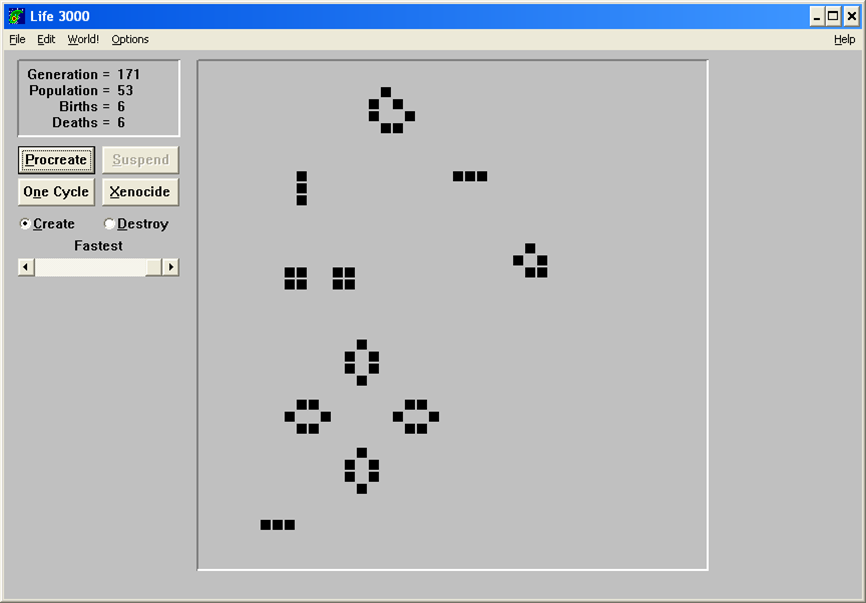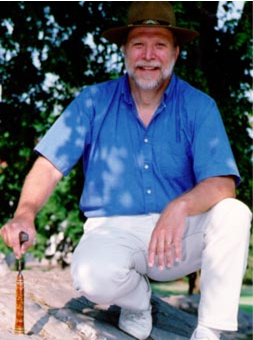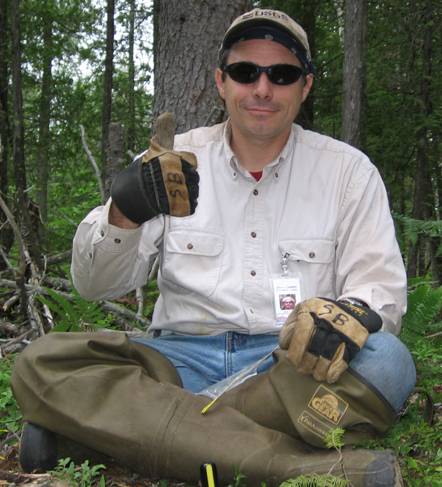James Madison University - Department of Geology & Environmental Science
Teaching Chaos and Complex Evolutionary Systems Theories at the Introductory Level
(Back to Self-Organized Criticality) (To Bak-Sneppen Ecosystem Model)
Model: Cellular Automata
Self-Organizing EvolutionStrategies and Rubrics for Teaching Chaos and Complex Systems Theories as Elaborating, Self-Organizing, and Fractionating Evolutionary Systems,
Fichter, Lynn S., Pyle, E.J., and Whitmeyer, S.J., 2010, Journal of Geoscience Education (in press)Description: A cellular automata is a grid of cells, something like a checkerboard. Each cell in the grid may take on a series of states depending on the rules of the system; simplistically, the cells are either alive (light up), or dead (blank), although they can be any set of states a person desires, like the three primary colors, or the six colors of the secondary color wheel.
Cellular automata are excellent systems to visually demonstrate self-organization, but take a little more time to develop than boids. On the other hand, CA have so many applications in so many disciplines for so many different kinds of complex systems that they are becoming de rigeur in some fields.
The simplest CA local rules are “survival neighbors,” and “birth neighbors.” Take a live cell, what will insure its survival to the next generation? The live cell is surrounded by eight other cells. It will survive if at least 2 or 3 of the surrounding cells are alive, but not more than 3; any 2 or 3 of the 8 cells will do. Take a dead cell, what will allow it to birth the next generation? It will come alive if 3 and only 3, any 3, of the surrounding cells are also alive. Many different rule sets are possible, and for some systems such as oscillating chemical reactions we want rules that model the chemical processes. At the introductory level we primarily want to demonstrate self-organization.
All this is good enough to say, but nothing substitutes for putting a CA model up, swirling a mass of random cells, and watching it self-organized right in front of your eyes.
Presentation: We use one of the oldest CA programs called Life3000 by David Bunnell (also Mirek's Celebration; more powerful, more complicate; check out the "Must See" files) . It is simple, neat, and very easy to use. Since we are demonstrating self-organization we take the time in class to discuss the local rules and have the students, via discussion, calculate the fate of a single cell, or variety of cell combinations. We want them to unambiguously understand that the outcome of the demonstrations is not pre-programmed in; that it is deterministic and stems solely from the local rules–global behavior concept.
The demonstration itself is simple. Hold the mouse button down while swirling the cursor across the grid to create an unorganized splay of live cells. Then run the program; the cells, after varying times and complexities of activity, will settle down to an end state of simple, static, geometric arrangements of cells (point attractors), or oscillating arrangements of cells (limit cycle attractors). Run the experiment as many times as desired, each time starting off with a different random splay of cells. The system will always self-organize to the same basic kinds of arrangements, although the distribution will be different for each different initial state. Sensitive dependence can also be demonstrated: after the system has stabilized; add one live cell and set it running again. Depending on where the cell is located there will occur another avalanche of changes lasting anywhere from 1 generation, to many dozens of generations. If one continues to do this, keeping track of the length of the avalanches, they will be seen to follow a power law distribution.
If we have the time we do demonstrations from some of the other CA programs available on line to show the complexity and intricacy of behaviors that occur with different rule sets (see Mirek's Celebration; "Must See" files). There is almost no limit to the modelling possible with CA; it is a big field in mathematics. See for example Forrest and Haff (1992) for a CA model on eolian ripple formation.
Anticipated Learning Outcome:
- 17. (Same as last but with a different model.) All natural open systems dissipating sufficient energy evolve—self-organize—to critical, sensitive dependent states which lead to avalanches of change that follow a power law distribution.
Power Point - Cellular Automata
Lab Experiments - Cellular Automata
Contains student lab exercises, but also can be used as a source of demonstrations. Some require programs other than Life3000: see Resources SectionLife3000
- a simple, effective, cellular automata program Life3000 Help File
Mirek's Celebration (MCell)
- a more powerful, more complicated, more flexible cellular automata; check out the "Must See" files.(Back to Self-Organized Criticality) (To Bak-Sneppen Ecosystem Model)
 Lynn S. Fichter
Lynn S. Fichter
 Steve Baedke
Steve Baedke
 Eric Pyle
Eric Pyle
 Steve Whitmeyer
Steve Whitmeyer